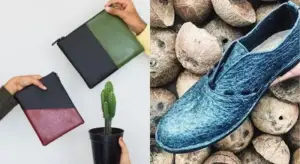Can you wear leather boots in the rain? (Here’s why Not)
Boots made of leather are highly adaptable. They go well with skirts, dresses, shorts, or jeans and can be worn in the winter or the summer. They are in essence, seasonless. But Can you wear leather boots in the rain?
Yes, you can wear your leather boots in the rain. However, you shouldn’t have them out in the rain for an extended period of time. This is because leather absorbs moisture if they aren’t coated with a decent waterproofing product.
So, what happens when leather boots become wet? And how can you properly dry them? That’s what we are going to cover in this post.
We’ll also cover how to waterproof leather boots and suggest the best items to use in that regard.
Can you wear leather boots in the rain?
It’s okay to wear leather boots in the rain but prolonged contact with moisture or water will deteriorate the material and the stitching. This is due to the fact that leather is porous, meaning that without a protective treatment, it will absorb water or moisture and become damp.
To name a few, avoid donning leather boots in the rain for the following reasons:
1. Leather becomes moist and heavy
After tanning, leather is typically given a protective coating to make it water-resistant. However, because leather is porous, this does not make it completely waterproof.
The protective finish on your boots wears off if you repeatedly subject them to heavy rain or water.
This exposes the leather allowing water to enter its pores. Your leather boots or shoes as a result become extremely heavy and soaked and will eventually shrink as they dry.
2. Leather loses its natural oils when exposed to water
Your leather boots lose their natural oils when they are exposed to too much water over a long period causing them to dry.
As the leather dries, it becomes brittle and may begin to crack, flake, or peel.
3. Water discolors and stains leather
If exposed to prolonged, heavy rain and improperly dried, your leather boots may potentially stain and lose their color.
If leather shoes are not thoroughly dried after exposure to moisture, water spots, discolouration, and damaged leather can result. Leather shoes shouldn’t be dried using heat sources like radiators or hair dryers.
However, that depends on whether the leather that was used to construct your boots was treated or not.
If your boots are made of aniline leather, for instance, you can encounter stains and discoloration.
Due to its lack of surface treatment, aniline leather is quite delicate so, it often stains quickly and is prone to getting wet quickly. For this reason, boots made from aniline leather tend to discolor when they get wet.
4. Rotting and deterioration of leather
Given that leather’s fibers are saturated with water while it is wet, it may take some time for it to entirely dry out.
As a result, your leather boots may become more prone to mold and mildew growth if not dried correctly because the fungi thrive in wet environments.
Eventually, begins to have a strong odor due to the mold. As the microbes consume the leather, the boots and the stitching may also begin to deteriorate and rot.
How to protect your leather boots from rain

Given its porous nature, leather absorbs water when it rains heavily because the fibers allow water to seep through.
However, you can avoid this by routinely conditioning or waxing your leather boots.
Using the right leather conditioner or wax will help to establish a barrier on the boot’s surface and stop water from penetrating the leather.
Follow these steps to protect your boots:
Step 1: Apply wax
Applying wax to your leather boots is one technique to make them more water-resistant.
Water cannot seep into the boots because wax adds a waterproof covering to the leather’s surface.
Additionally, it gives the boots a lovely shine and restores the leather color.
Although there are many different kinds of waxes, Sno-Seal Original Beeswax comes highly recommended for waterproofing leather boots.
Your boots get a quick, long-lasting water-resistant coating from Sno-Seal that keeps them dry even in a torrential downpour when hiking, mountaineering, or fishing.
Step 2: Condition the leather boots often
Using a suitable leather conditioner, such as Chemical Guy’s Conditioner, is another approach to making your leather boots water-repellent.
Since leather naturally loses moisture, the conditioner hydrates the shoes and offers a barrier that keeps water out.
Although you can prepare your own leather conditioner at home, I wouldn’t suggest it. The cause of this is that if the proportions are off, it could destroy your leather boots.
Additionally, leather conditioners are easily available and reasonably priced. There is no need for you to go through the hassle of buying and combining the components at home.
Step 3: Use silicone spray
Leather’s capacity to repel water is significantly improved when 100% silicone polymer is applied to the boots.
It particularly works great when it comes to waterproofing suede, which is a type of napped leather.
All you need to do is spray the silicone on the leather boots to create a slick layer on the leather surface. This layer protects the leather by making water beads on the surface of the boots rather than soaking it.
Conclusion
Similar to wearing a leather jacket in the rain, wearing leather boots in the rain is also okay. However, to keep the boots from getting wet, make sure they have been coated with a waterproof substance.
When you get caught in the rain, consider doing the following if you want your leather boots to last longer;
- Dry the shoes as soon as you get home.
- Don’t put leather in the dryer as it can get ruined
- Condition or wax your leather boots or shoes once they are completely dry.
- Store your leather boots in a dry and airy place






